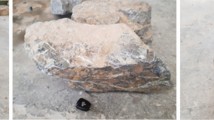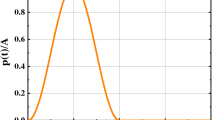Abstract
Fragmentation of granite cylinders having a centric charge with different decoupling ratios was investigated in blast experiments. Conclusions are made from studying the post-blast specimens and strain measurement. Eight blasting tests were carried out on granite cylinders having a diameter of 240 mm and a length of 300 mm. All the specimens had a charge (PETN) of approximately 3 g, and the charge diameter was around 6 mm. A centric hole with a diameter of 10 mm, 14 mm or 20 mm was drilled for each cylinder, and the decoupling ratio was in the range of 1.8–3.6. Specimens had a decoupled charge with either water or air. Strain gauges were mounted on the lateral surface to measure circumferential strains. After each blast, fragments were collected and screened with a set of sieves. The specimen with a low decoupling ratio and the water-decoupled charge was mainly fragmented into small fragments, while the specimen with a high decoupling ratio and the air-decoupled charge mainly broken into large fragments. The normalized median size tended to have a linear relationship with the decoupling ratio, and the slopes for air-filled blastholes and water-filled blastholes were 0.179 and 0.094, respectively. With increasing decoupling ratio, the measured maximum strain decreased from 4910 με to 2420 με, and the tension part of dominant strain waves increased from 490 to 780 μs. The findings of this experimental investigation indicate that the decoupling ratio and the filling medium have a great impact on rock fragmentation as the charge weight and other conditions remain the same.
Highlights
-
Granite cylinders with an air-decoupled or water-decoupled charge were blasted.
-
Conclusions are made from fragment size distribution and strain measurement on cylindrical surface.
-
The normalized median size has a linear relationship with the decoupling ratio in the range of 1.8-3.6.
-
With increasing decoupling ratio, the maximum of measured circumferential strain decreases from 4910 με to 2420 με.












Similar content being viewed by others
Abbreviations
- a :
-
Partition coefficient
- b, c :
-
Undulation parameter
- L granite :
-
Length of specimen
- P(x):
-
Material mass passing mesh size x (%)
- R D :
-
Decoupling ratio
- x, x max, x 50 :
-
Fragment size, maximum size, median size
References
Banadaki MMD, Mohanty B (2012) Numerical simulation of stress wave induced fractures in rock. Int J Impact Eng 40–41:16–25. https://doi.org/10.1016/j.ijimpeng.2011.08.010
Chi LY, Zhang ZX, Aalberg A et al (2019a) Fracture processes in granite blocks under blast loading. Rock Mech Rock Eng 52:853–868. https://doi.org/10.1007/s00603-018-1620-0
Chi LY, Zhang ZX, Aalberg A, Li CC (2019b) Experimental investigation of blast-induced fractures in rock cylinders. Rock Mech Rock Eng 52:2569–2584
Dai F, Huang S, Xia K, Tan Z (2010) Some fundamental issues in dynamic compression and tension tests of rocks using split Hopkinson pressure bar. Rock Mech Rock Eng 43:657–666. https://doi.org/10.1007/s00603-010-0091-8
Djordjevic N (1999) A two-component model of blast fragmentation. In: Proceedings of the 6th international symposium on rock fragmentation by blasting, Johannesburg, South Africa, pp 213–219
Duvall WI, Atchison TC (1957) Rock breakage by explosives. US Bureau of Mines
Field JE, Ladegaard-Pedersen A (1971) The importance of the reflected stress wave in rock blasting. Int J Rock Mech Min Sci Geomech Abstr 8:213–226
Fourney WL (2015) The role of stress waves and fracture mechanics in fragmentation. Blast Fragm 9:83–106
Fourney WL, Dally JW, Holloway DC (1978) Controlled blasting with ligamented charge holders. Int J Rock Mech Min Sci Geomech Abstr 15(3):121–129
Fourney WL, Barker DB, Holloway DC (1981) Model studies of explosive well stimulation techniques. Int J Rock Mech Min Sci Geomech Abstr 18:113–127. https://doi.org/10.1016/0148-9062(81)90737-3
Fourney WL, Dick RD, Wang XJ, Wei Y (1993) Fragmentation mechanism in crater blasting. Int J Rock Mech Min Sci Geomech Abstr 30(4):413–429
Furtney JK, Cundall PA, Chitombo GP (2009) Developments in numerical modeling of blast induced rock fragmentation: updates from the HSBM project. In: Proceedings of the 9th international symposium on rock fragmentation by blasting, p 335
Han H, Fukuda D, Liu H et al (2020) FDEM simulation of rock damage evolution induced by contour blasting in the bench of tunnel at deep depth. Tunn Undergr Space Technol 103:103495
Hashemi AS, Katsabanis P (2020) The effect of stress wave interaction and delay timing on blast-induced rock damage and fragmentation. Rock Mech Rock Eng 53:2327–2346
He C, Chen D, Xiao J et al (2021) Experimental study of crack propagation and failure around a horseshoe tunnel during nearby blasting. Int J Rock Mech Min Sci 139:104628
Johansson D, Ouchterlony F (2013) Shock wave interactions in rock blasting: the use of short delays to improve fragmentation in model-scale. Rock Mech Rock Eng 46:1–18
Johansson CH, Persson P-A (1970) Detonics of high explosives. Academic Press, New York
Kanchibotla SS, Valery W, Morrell S (1999) Modelling fines in blast fragmentation and its impact on crushing and grinding. In: Explo ‘99—a conference on rock breaking. The Australasian Institute of Mining and Metallurgy, Kalgoorlie, Australia, pp 137–144
Kirk S (2014) Shock compression and dynamic fragmentation of geological materials. University of Cambridge, Cambridge
Kutter HK, Fairhurst C (1971) On the fracture process in blasting. Int J Rock Mech Min Sci Geomech Abstr 8:181–202. https://doi.org/10.1016/0148-9062(71)90018-0
Langefors U, Kihlström B (1963) The modern technique of rock blasting. Wiley, New York
Lu W, Leng Z, Chen M et al (2016) A modified model to calculate the size of the crushed zone around a blast-hole. J S Afr Inst Min Metall 116:412–422
Mahanta B, Singh TN, Ranjith PG (2016) Influence of thermal treatment on mode I fracture toughness of certain Indian rocks. Eng Geol 210:103–114
Monjezi M, Singh TN, Khandelwal M et al (2006) Prediction and analysis of blast parameters using artificial neural network. Noise Vib Worldw 37:8–16
Monjezi M, Dehghani H, Singh TN et al (2012) Application of TOPSIS method for selecting the most appropriate blast design. Arab J Geosci 5:95–101
O’keefe SG, Thiel DV (1991) Electromagnetic emissions during rock blasting. Geophys Res Lett 18:889–892
Onederra IA, Furtney JK, Sellers E, Iverson S (2013) Modelling blast induced damage from a fully coupled explosive charge. Int J Rock Mech Min Sci 58:73–84
Ouchterlony F (2005) The Swebrec© function: linking fragmentation by blasting and crushing. Min Technol 114:29–44
Ouchterlony F (2016) The case for the median fragment size as a better fragment size descriptor than the mean. Rock Mech Rock Eng 49:143–164
Ouchterlony F, Sanchidrián JA, Moser P (2017) Percentile fragment size predictions for blasted rock and the fragmentation—energy fan. Rock Mech Rock Eng 50:751–779
Persson P-A, Holmberg R, Lee J (1993) Rock blasting and explosives engineering. CRC Press, Boca Raton
Saharan MR, Mitri HS, Jethwa JL (2006) Rock fracturing by explosive energy: review of state-of-the-art. Fragblast 10:61–81
Sanchidrián JA, Ouchterlony F (2017) A distribution-free description of fragmentation by blasting based on dimensional analysis. Rock Mech Rock Eng 50:781–806
Sanchidrián JA, Ouchterlony F, Segarra P, Moser P (2014) Size distribution functions for rock fragments. Int J Rock Mech Min Sci 71:381–394
Sanchidrián JA, Segarra P, López LM, et al (2009) Evaluation of some distribution functions for describing rock fragmentation data. In: Proceedings of Fragblast 9, Proceedings of the ninth international symposium on rock fragmentation by blasting. Taylor & Francis Group, London, pp 239–248
Sazid M, Singh TN (2013) Two-dimensional dynamic finite element simulation of rock blasting. Arab J Geosci 6:3703–3708
Tilert D, Svedbjörk G, Ouchterlony F et al (2007) Measurement of explosively induced movement and spalling of granite model blocks. Int J Impact Eng 34:1936–1952. https://doi.org/10.1016/j.ijimpeng.2006.11.006
Weibull W (1951) Wide applicability. J Appl Mech 103:293–297
Yang R, Ding C, Yang L et al (2019) Study of decoupled charge blasting based on high-speed digital image correlation method. Tunn Undergr Space Technol 83:51–59
Yilmaz O, Unlu T (2013) Three dimensional numerical rock damage analysis under blasting load. Tunn Undergr Space Technol 38:266–278
Yuan W, Wang W, Su X et al (2019) Experimental and numerical study on the effect of water-decoupling charge structure on the attenuation of blasting stress. Int J Rock Mech Min Sci 124:104133
Zhang ZX (2016) Rock fracture and blasting: theory and applications. Butterworth-Heinemann, London
Zhang QB, Zhao J (2013) Determination of mechanical properties and full-field strain measurements of rock material under dynamic loads. Int J Rock Mech Min Sci 60:423–439. https://doi.org/10.1016/j.ijrmms.2013.01.005
Zhang ZX, Hou DF, Guo Z et al (2020a) Experimental study of surface constraint effect on rock fragmentation by blasting. Int J Rock Mech Min Sci 128:104278
Zhang ZX, Hou DF, Guo Z, He Z (2020b) Laboratory experiment of stemming impact on rock fragmentation by a high explosive. Tunn Undergr Space Technol 97:103257
Zhang ZX, Chi LY, Qiao Y, Hou DF (2021a) Fracture initiation, gas ejection, and strain waves measured on specimen surfaces in model rock blasting. Rock Mech Rock Eng 54:647–663
Zhang ZX, Qiao Y, Chi LY, Hou DF (2021b) Experimental study of rock fragmentation under different stemming conditions in model blasting. Int J Rock Mech Min Sci 143:104797
Acknowledgements
This work was funded by the National Natural Science Foundation of China (no. 12002047 and no. 11732003).The authors wish to thank Mr. J.Y. Yang, Dr. D. Zhang, Mr. Z.X. Wang, and Mr. Feng at the Beijing Institute of Technology for the support in performing the experiments at the State Key Laboratory of Explosion Science and Technology. The authors also thank the reviewers for their valuable comments and suggestions.
Author information
Authors and Affiliations
Corresponding authors
Ethics declarations
Conflict of interest
The authors declare that there is no conflict of interest associated with this publication.
Additional information
Publisher's Note
Springer Nature remains neutral with regard to jurisdictional claims in published maps and institutional affiliations.
Rights and permissions
About this article
Cite this article
Chi, L.Y., Wang, C., Zhang, ZX. et al. Experimental Investigation of Decoupled Charge Effect on Rock Fragmentation by Blasting. Rock Mech Rock Eng 55, 3791–3806 (2022). https://doi.org/10.1007/s00603-022-02823-w
Received:
Accepted:
Published:
Issue Date:
DOI: https://doi.org/10.1007/s00603-022-02823-w




